If you want to build a bigger and stronger rear delt, you should add rear delt fly to your shoulder workout routine.
Why are rear delt flys so vital? The rear delt flys are the best exercise for targeting your upper back muscles and shoulder muscles, particularly the posterior deltoids, or rear deltoids, on the backside of your shoulders.
It helps you to hone in on the small muscles of the rear delt by using a full range of motion that will explore the growth of your shoulder muscles.
In this beginner guide, we will explore the following:
- What is Rear Delt Fly
- Muscles Worked During Dumbbell Rear Delt Fly
- How To Do Dumbbell Rear Delt Fly Properly
- Best Variations
- Best Alternate
- Benefits of Rear Delt Fly
- FAQs

- What is Rear Delt Flys
- Rear Delt Fly Muscles Worked
- How To Do Rear Delt Fly Properly
- Rear Delt Fly Proper Form And Technique
- Set, Reps And Frequency For Rear Fly
- Beginner
- Intermediate
- Advanced
- Tips For Increasing Weight And Reps
- Best Variations of Rear Delt Fly
- 1. Seated Dumbbell Rear Delt Fly
- 2. Machine Rear Delt Fly
- 3. Cable Rear Delt Fly
- 4. Incline Bench Rear Delt Dumbbell fly
- 5. Side-Lying Rear Delt Dumbbell Fly
- 6. Lying Reverse Cable Fly
- 7. One-Arm Rear Delt Cable Fly
- 8. Standing Reverse Fly with Resistance Bands
- 9. Lying Reverse Dumbbell fly
- 10. Head Supported Reverse Dumbbell Fly
- Add Rear Delt Fly Into Your Workout Routine
- Sample Workout Routine
- Best Alternate of Rear Delt fly
- Benefits of Rear Delt Fly
- FAQs
- How Should I Integrate Rear Delt Fly Into The Rest Of My Workout?
- What equipment do I need to perform the rear delt fly exercise?
- How often should I perform the rear delt fly exercise?
- Can I perform the rear delt fly exercise at home without equipment?
- Can I perform the rear delt fly exercise if I have shoulder pain or injury?
- Can the rear delt fly exercise help improve my posture?
- What other exercises can I perform to target the rear deltoids?
- Takeaways
- References
- 12 Best Rear Delt Exercises To Build Mass and Strength
What is Rear Delt Flys
The rear delt fly, also known as the bent over rear delt fly, is a great shoulder exercise to assist you in building a rear delt muscles. Many lifters utilize the rear delt fly to target the rear delts, an often lagging muscle for many lifters alike.
While many shoulder exercises like overhead presses and lateral raises work the front and side delts, the Rear Delt Fly places particular emphasis on the rear deltoids. It helps you build strength, stability, and size in your shoulders.
Strengthening the rear delts by using the bent over rear delt fly can lead to improved posture and a greater level of strength on other lifts.
There are many variations of rear delt flys that you can add to your workout routine, and all have their own unique benefits.
- Dumbbell Rear Delt Fly: Enhances shoulder stability with free weights.
- Machine Rear Fly: Targets rear deltoids with controlled resistance.
- Cable Rear Delt Fly: Constant tension for efficient muscle activation.
- Incline Bench Rear Dumbbell Fly: Increases stretch and contraction for rear delt development.
- One-Arm Rear Delt Cable Fly: Improves symmetry and targets rear deltoid isolation.
- Resistance Bands Reverse Fly: Portable option for rear delt training.
- Lying Reverse Fly: Isolates rear deltoids for targeted growth.
Rear Delt Fly Muscles Worked
The rear delt flys, primarily works the rear delt and a handful of other muscles worked or play the role of stabilizer muscles, including your Lateral deltoid, trapezius, rhomboids, infraspinatus, teres minor, teres major.
The standing rear delt fly has the involvement of several synergist muscles, these muscles include, oblique and core muscles.
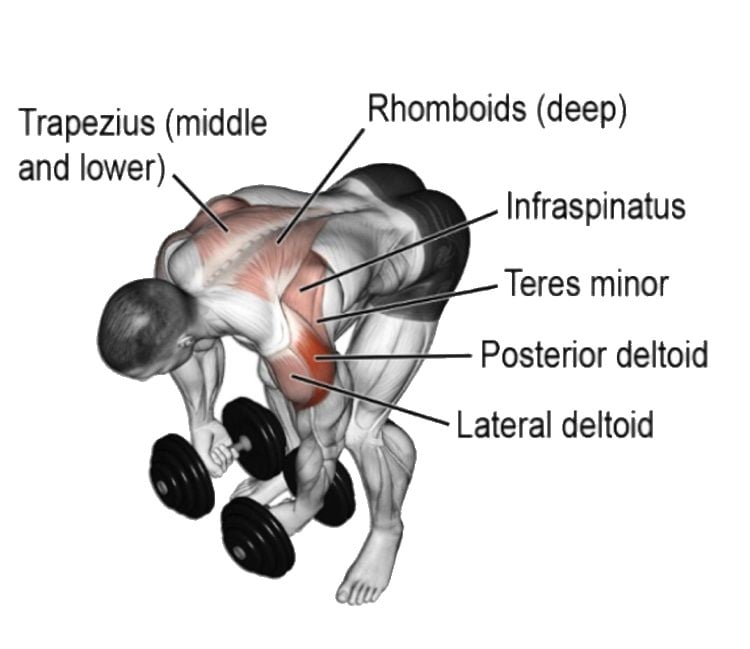
- Rear Delt: It engages to lift the weights or resistance laterally away from the body, making them the main muscles worked in this movement.
- Trapezius: The upper and middle fibers of the trapezius help stabilize the shoulders during the exercise.
- Rhomboids: These muscles located between the shoulder blades assist in shoulder retraction.
- Rotator Cuff Muscles: The infraspinatus and teres minor play a role in shoulder external rotation, synergistically supporting the rear deltoids.
- Posterior Serratus: helps stabilize the scapula during the exercise.
- Core and Abs: Help to stabilize the body.
How To Do Rear Delt Fly Properly
- Starting Position: Stand with your feet shoulder-width apart, hold a dumbbell in each hand.
- Grip: Hold the dumbbells with a neutral grip (palms facing each other) and let your arms hang naturally in front of your body.
- Bend at the Hips: Bend forward at the hips and maintain a flat back. Your torso should be almost parallel to the ground.
- Fly Movement: Keep your arms slightly bent and lift the dumbbells laterally away from your body and squeeze your shoulder blades together.
- Shoulder Height: Lift the dumbbells to shoulder height or slightly higher, to ensure that your arms are parallel to the ground at the top of the movement.
- Controlled Descent: Lower the dumbbells back to the starting position in a controlled manner.
- Breathing: Inhale as you lower the weights, and exhale as you lift them.
- Repetitions and Sets: Aim for 10-15 repetitions per set. Perform 3-4 sets with a short rest period in between.
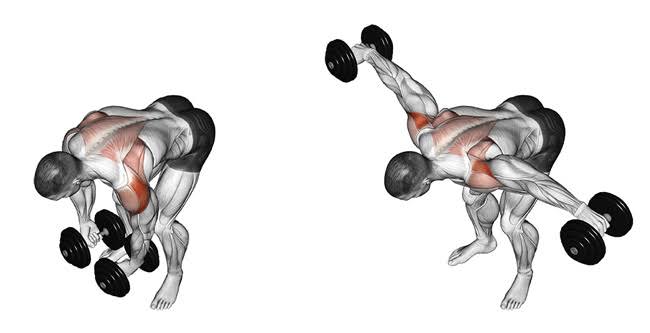
Rear Delt Fly Proper Form And Technique
- Avoid using excessive momentum or swinging your body in order to lift the weight. Focus on using your rear delt to control the movement.
- Maintain a neutral spine and avoid arching your back or rounding your shoulders.
- A slow controlled descent will increase time under tension, leading to more effective sets, and less risk of injury.
- Inhale as you lower the weights and exhale as you lift them, coordinating your breathing with the movement.
- You should focus on the contraction of the rear delt at the top of the movement.
- Always select a weight that allows you to have full control of your body.
- Incorporate proper warm-ups, rest, and nutrition into your exercise program.
- Rest for 24 to 48 hours before training the same muscle groups to allow sufficient recovery.
- Perform this exercise in a slow, controlled manner for best results.
- Don’t go heavy. Choose a lighter weight and focus on perfecting your form.
Set, Reps And Frequency For Rear Fly
The number of reps you should do depends on your goals, whether they are to increase strength or build muscle mass and endurance.
- For muscle growth, it is best to do for around 6–12 reps per set.
- For strength, around 3–8 reps per set are recommended.
- To build Muscle Endurance, do 15-20+ reps per set.
Here are some general guidelines for the rear fly exercise, including sets, reps, and frequency, in order to build muscle mass
Beginner
If you’re new to rear delt flys or strength training in general, start with lighter weights and focus on mastering proper form and technique.
| Sets | Reps | Frequency |
|---|---|---|
| 2-3 | 8-12 | 1-2 times per week |
Intermediate
Once you’re comfortable with the exercise, gradually increase the weight and intensity.
| Sets | Reps | Frequency |
|---|---|---|
| 3-4 | 8-12 | 2-3 times per week |
Advanced
As an advanced fitness enthusiast, you can add more sets, higher weights, and advanced variations to your shoulder fly workouts.
| Sets | Reps | Frequency |
|---|---|---|
| 4-5 | 8-15 | 2-3 times per week |
Tips For Increasing Weight And Reps
Once you’ve mastered proper form with a lighter weight, you can start to increase the weight and reps. However, it’s important to do so safely and gradually.
- Start by increasing the weight by 5-10% and reducing your reps to 6-8.
- However, it’s important to listen to your body and avoid pushing yourself too hard.
- It’s also important to give your muscles time to recover between workouts.
Best Variations of Rear Delt Fly
It can be beneficial to incorporate different variations of the rear delt fly exercise.
- Firstly, by changing up the angle of the movement or the type of equipment used, you can activate different muscle fibers in the rear deltoids and prevent plateauing. This can result in increased strength and muscle growth.
- Secondly, varying your exercise routine can help prevent boredom and keep your workouts interesting and challenging.
- Lastly, using different versions of the rear delt fly can help prevent injury by making sure that you are working all areas of the muscle group and not just one.
1. Seated Dumbbell Rear Delt Fly
Dumbbell rear delt fly is an excellent exercise to isolate and work specifically on the rear deltoid muscles. In this version, you do the movement while sitting, which gives you more support and stability during the workout.
Therefore, the exercise targeted the rear delt head in a more targeted manner by isolating it more effectively than any other shoulder exercise.
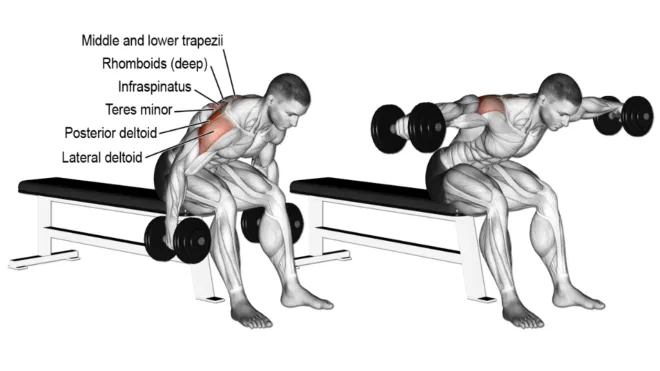
How To Do Seated Dumbbell Rear Fly
- Sit at the end of a bench with a pair of dumbbells.
- Bend forward and let the dumbbells hang on your sides.
- Lift the weights by lifting them on your sides to a higher level than your shoulders.
- Now lower the dumbbells back to your sides.
Pro Tips
- Keep your neck relaxed and avoid straining it during the exercise.
- Do the movement slowly and with control.
2. Machine Rear Delt Fly
The machine rear delt fly ensures precise targeting of the rear deltoids, minimizing involvement of other muscle groups. It provides a uniform resistance throughout the range of motion.
This machine also offers several technical adjustments to the grip. Trajectory and range of motion to help isolate the posterior deltoid.
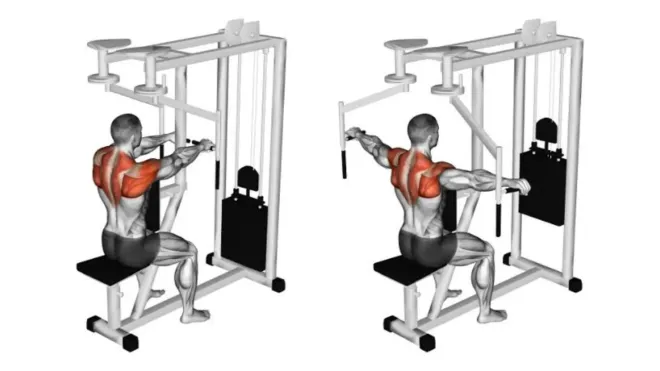
How To Do Machine Rear Fly
- Adjust the seat height and machine handles to align with your shoulder height.
- Sit facing the machine with your chest against the backrest.
- Grab the handles in front with your arms stretched out at shoulder level.
- Pull the handles back in an arc as far as possible, keep your elbows high and arms parallel to the floor.
- Return the handles to the start position directly in front.
Pro Tips
- Avoid using excessive momentum.
- Maintain a slight bend in your elbows and a neutral wrist position
- Remember to exhale while you exert.
3. Cable Rear Delt Fly
A rear delt cable fly is an excellent exercise to train and isolate the rear deltoid muscle. It provides constant tension on the muscle. Unlike dumbbell raises where the resistance varies during the lift, the cable pulley affords a uniform resistance throughout the motion.
There are, however, many bent-over cable lateral raise variations that you can try out that may require different types of bent-over cable lateral raise equipment.

How To Do Cable Rear Delt Fly
- Grab the handles attached to two low pulleys (left-side handle in right hand, right-side handle in left hand), stand in the middle, then bend forward at the waist with back straight and parallel to the floor.
- Raise your hands upward in an arc to shoulder level, such that the cables cross over.
- Lower the handles back down to the start position, your right hand directly in front of the left ankle and your left hand in front of the right ankle.
4. Incline Bench Rear Delt Dumbbell fly
The incline bench delt dumbbell fly makes the rear deltoids stretch and contract more, which helps them grow stronger.
This exercise targets such small muscles, that’s why it is usually performed with lightweight for high reps, such as 10-15 reps per set or more.
Incline Bench Rear delt dumbbell fly has many other benefits, such as it adds size and strength to the posterior deltoids.
The incline bench takes away the potential of using momentum and makes the movement more challenging. Rear delt exercise develops bigger, more balanced, and healthier shoulders.

How To Do Incline Bench Rear Delt Dumbbell fly
- Sit in the reverse direction on an incline bench (45 degrees) while holding dumbbells with neutral grips.
- Hold the dumbbells so that they hang straight down from your shoulders.
- Slowly lift the dumbbells up and out to the sides of your body, pulling through the rear delts and middle traps.
- Pause for a moment at the top of the motion before slowly lowering the weights back down to the starting position.
Pro Tips
- Do not arch your back or shrug your shoulders.
- Focus on squeezing your rear deltoids at the top of the movement.
5. Side-Lying Rear Delt Dumbbell Fly
The side-lying reverse dumbbell fly is also known as the side-lying dumbbell rear delt raise.
It’s a great shoulder workout that targets the rear delts. It is a great unilateral exercise used to target a smaller and often lagging muscle group. Instead of lying on the floor, you can lie on a bench.

How To Do Side-Lying Reverse Dumbbell Fly
- Lie on the floor on your right side, and grasp the dumbbell with your left hand using a neutral grip (palm facing downward).
- Exhale as you raise the dumbbell from the floor until it is almost vertical. Hold for a count of two.
- Inhale as you reverse the movement and lower the dumbbell towards the starting position, stopping before the dumbbell touches the floor.
- Repeat for the desired number of repetitions.
- Repeat the exercise on your opposite side with your right arm.
Pro Tips
- Do not allow the dumbbell to touch the floor.
- Keep the abs braced, and don’t arch the back at the top of the movement.
- Allow the arms to move freely, but don’t lock out the elbows.
6. Lying Reverse Cable Fly
The lying reverse fly is the perfect exercise to hit the rear delts. Completing this exercise in a supine position on your back allows you to purely focus on contracting your rear delts in order to pull the cables down to the sides.
It’s important to keep your arms perpendicular to your trunk so that you reduce the chances of your lats helping to complete the exercise.

How To Do Lying Reverse Cable Fly
- Position a flat bench between two high pulleys.
- Lie supine (on your back) holding the pulleys’ handles. The handle from the right pulley should be in your left hand, and the handle from the left pulley should be in your right hand. The cables should be crossed and pulled tightly.
- Keeping your arms perpendicular to your torso and your elbows slightly bent, exhale as you pull your arms open and out to the sides.
- Hold for a count of two. Inhale as you slowly return to the starting position. Repeat for desired reps.
7. One-Arm Rear Delt Cable Fly
You can do this exercise using one arm at a time, allowing you to alter the range of motion by adjusting the start or finish position.
This unilateral version makes it possible to raise your hand higher and get a longer stretch at the bottom, thereby generating more work for the posterior deltoid. Stabilize your torso by resting your free hand on your thigh.

How To Do One-Arm Rear Delt Cable Fly
- Lean forward at the hips, place your right hand on your thigh and hold a dumbbell in your left hand with your arm extended straight down.
- Raise the weight straight out to the side until your arm is parallel with the floor.
- Pause for a moment at the top of the motion before slowly lowering the weight back down to the starting position.
- Repeat with the right arm.
8. Standing Reverse Fly with Resistance Bands
This is a movement that can be done on shoulder day, as it targets the rear delts. However, we like to also hit it on a back day as the rear delts often need to double the work each week.
The rear delt fly with bands will work your rhomboids, rear delts, and traps. It’s a great upper back exercise.

How To Do Standing Band Reverse Fly
- Stand with your feet shoulder-width apart, keeping a slight bend in the knees.
- Place a band around a stationary post, such as a squat rack.
- Hold the exercise band in front of you with your hands slightly lower than your shoulders.
- Keep your elbows slightly soft to avoid hyperextending the joint.
- Squeeze the shoulder blades together and open the arms out to either side, pulling the band apart and squeezing your shoulder blades.
- Return to start and repeat, keeping tension on the band the entire time.
9. Lying Reverse Dumbbell fly
Lying Dumbbell Reverse Fly is a strength exercise that works your traps and deltoids. If the traditional dumbbell rear delt fly causes strain on your lower back, try using an incline bench.
Instead of relying on your core to stabilize your body, you can rest your weight on the bench, which will help to better isolate your rear deltoids.
Lying rear delt fly is a great basic move. When done correctly, it can effectively target your neck, shoulders, upper back and upper body.
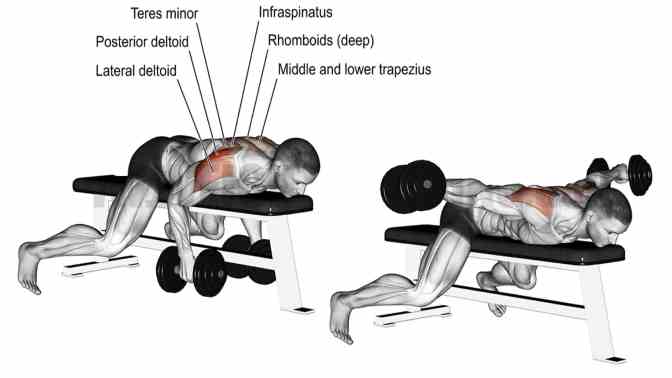
How To Do Lying Reverse Dumbbell fly
- Place two dumbbells on the floor, one on each side of a flat bench.
- Lie prone (on your front) on the bench and grasp a dumbbell in each hand.
- Spread your legs on the floor for support.
- Keeping your elbows slightly bent, raise both arms out to the sides until the dumbbells are level with the height of your shoulders
- Hold for a count of two and then slowly lower the dumbbells to the starting position in a controlled manner.
- Repeat for the prescribed number of repetitions.
10. Head Supported Reverse Dumbbell Fly
The head-supported rear delt dumbbell fly is also known as the head-supported bent-over dumbbell reverse fly.
To target your posterior deltoids during the head-supported reverse dumbbell fly, keep your torso horizontal.
The more upright your torso is, the more emphasis you will place on your lateral deltoids instead of on your posterior deltoids.
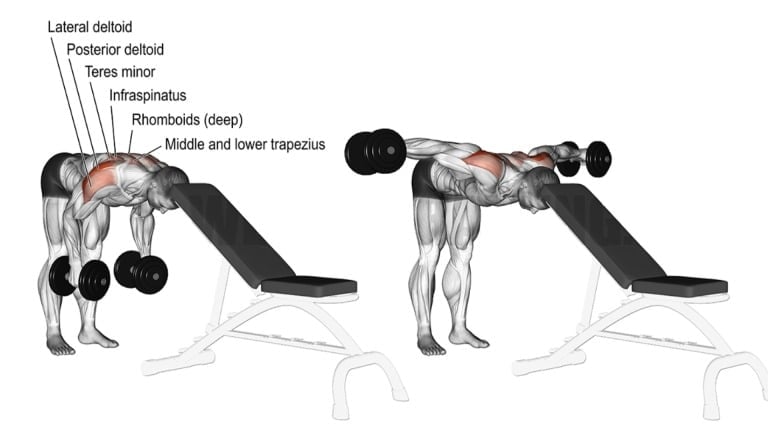
How To Do Head Supported Reverse Dumbbell Fly
- Raise a bench to hip height and, hold a dumbbell in each hand, bend at the hips and rest your forehead on the edge of the bench.
- The back should be straight and your arms should be hanging in front of you, with your palms facing inwards (neutral grip).
- Keeping your elbows slightly bent, raise both arms out to the sides until the dumbbells are level with the height of your shoulders
- Hold for a count of two and then slowly lower the dumbbells to the starting position in a controlled manner.
- Repeat for the desired number of repetitions.
Add Rear Delt Fly Into Your Workout Routine
The rear delt flys can be incorporated into your workout routine in a variety of ways. Here are some options:
- As a standalone exercise: Do on 3-4 sets of 8-12 reps.
- As part of a shoulder workout: Do them along with other shoulder exercises.
- As part of a full-body workout: Do them with other compound exercises like squats, deadlifts, and bench presses.
Sample Workout Routine
1. Shoulder-Focused Workout Routine
| Exercise | Sets | Reps |
|---|---|---|
| Rear Delt Fly | 4 | 10-12 |
| Seated Shoulder Press | 3 | 8-10 |
| Lateral Raises | 3 | 12-15 |
| Front Raises | 3 | 10-12 |
| Face Pulls | 3 | 12-15 |
2. Upper Body Strength and Definition Routine
| Exercise | Sets | Reps |
|---|---|---|
| Barbell Rows | 4 | 8-10 |
| Pull-Ups | 3 | 8-10 |
| Dumbbell Bench Press | 3 | 8-10 |
| Cable Rear Delt Fly | 3 | 12-15 |
| Triceps Pushdowns | 3 | 10-12 |
3. Full Body Strength and Stability Routine
| Exercise | Sets | Reps |
|---|---|---|
| Deadlifts | 3 | 6-8 |
| Squats | 4 | 8-10 |
| Bent-Over Rows | 3 | 8-10 |
| Machine Rear Delt Fly | 3 | 12-15 |
| Incline Dumbbell Curl | 3 | 8-10 |
| Plank | 3 | 30 sec |
4. Push-Pull Split Routine (Pull Day)
| Exercise | Sets | Reps |
|---|---|---|
| Deadlifts | 3 | 6-8 |
| Pull-Ups | 4 | 8-10 |
| Cable Rear Delt Fly | 3 | 12-15 |
| Barbell Rows | 3 | 8-10 |
| Barbell Curl | 3 | 8-10 |
Best Alternate of Rear Delt fly
If you’re looking for a similar exercise to replace the rear delt fly during your training sessions, you can try these alternatives.
- Renegade Row
- Face pull
- T Bar Row
- Landmine Row
- Upright Row
- Rear Delt Row
- Lying dumbbell rear delt row
- bent-over lateral raises
Benefits of Rear Delt Fly
Rear delt fly exercises also help to:
- Targets and strengthens the rear deltoid muscles, promoting balanced shoulder development.
- Enhances shoulder stability and reduces the risk of injuries.
- Reinforces shoulder muscles used in daily activities, such as lifting and carrying objects.
- Maintain proper posture and reduce rounded shoulders.
- Boost shoulder stability
- Build symmetry with the shoulder, preventing a “forward sloping” look
- Improve shoulder function
- It can be performed with various equipment to suit your preferences.
FAQs
How Should I Integrate Rear Delt Fly Into The Rest Of My Workout?
The most natural place to include rear delt fly is with your other shoulder exercises.
Being an isolation exercise, beginners should probably perform them after any compound shoulder movements (such as shoulder press, etc.) have been completed.
More advanced trainers might want to try a pre-exhaustion routine. For example, where a set of rear delt flyes is immediately followed by a compound movement that also involves the rear delts (e.g., behind the neck press).
This enables the already fatigued rear deltoids to be driven into an even deeper state of exhaustion by the (relatively) fresh triceps and anterior/lateral deltoids.
What equipment do I need to perform the rear delt fly exercise?
The rear delt fly can be performed with a variety of equipment including dumbbells, resistance bands, cable machines.
Choose the equipment that is most comfortable and accessible for you.
How often should I perform the rear delt fly exercise?
The frequency of the rear delt fly exercise will depend on your fitness goals.
Generally, performing the exercise 1-2 times a week with 3-4 sets of 8-12 reps is sufficient for most people.
Can I perform the rear delt fly exercise at home without equipment?
Yes, you can perform a modified version of the rear delt fly exercise at home without equipment.
For example, you can perform a standing reverse fly by extending your arms out to the side and squeezing your shoulder blades together. You could also use a water bottle instead of dumbbells.
Can I perform the rear delt fly exercise if I have shoulder pain or injury?
If you have any pre-existing shoulder pain or injury, it is best to consult with a medical professional before performing the rear delt fly exercise.
In some cases, modifications may be necessary, or the exercise may need to be avoided altogether.
Can the rear delt fly exercise help improve my posture?
Yes, strengthening the rear deltoids can help improve posture.
This can help counteract the effects of sitting and working at a desk for long periods of time.
What other exercises can I perform to target the rear deltoids?
Some other exercises that target the rear deltoids include bent-over lateral raises, face pulls, and reverse flyes.
Doing a variety of exercises can help prevent plateaus and ensure that you are targeting all areas of the rear deltoid muscle group.
Takeaways
Now that you know a few variations for your rear delts fly, hit the gym and try each one to get the full effect. Don’t limit yourself to variations on this exercise, either.
Seek out new and interesting ways to perform all your staple movements so that you never get stuck waiting at the gym, never grow bored, and always keep growing.
References
- Campos YAC, Vianna JM, Guimarães MP, et al. Different Shoulder Exercises Affect the Activation of Deltoid Portions in Resistance-Trained Individuals. J Hum Kinet. 2020;75:5-14. Published 2020 Oct 31. doi:10.2478/hukin-2020-0033
- Lars L Andersen, Michael Kjær, Christoffer H Andersen, Peter B Hansen, Mette K Zebis, Klaus Hansen, Gisela Sjøgaard, Muscle Activation During Selected Strength Exercises, Physical Therapy, Volume 88, Issue 6, 1 June 2008
12 Best Rear Delt Exercises To Build Mass and Strength

Manish brings over 10 years of hands-on experience in weight lifting and fat loss to fitness coaching. He specializes in gym-based training and has a lot of knowledge about exercise, lifting technique, biomechanics, and more.
Through “Fit Life Regime,” he generously shares the insights he’s gained over a decade in the field. His goal is to equip others with the knowledge to start their own fitness journey.
